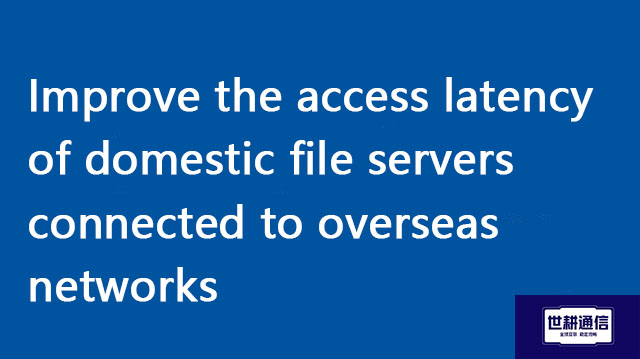Improve the access latency of domestic file servers connected to overseas networks//Global IPLC service provider of Shigeng Communication
一、In the context of globalization, more and more companies are setting up branches overseas. These branch offices need to frequently access domestic file servers to obtain necessary data and information. However, due to factors such as geographical distance, network infrastructure, and international bandwidth, the problem of access latency between overseas networks and domestic file servers is very serious, which seriously affects the operational efficiency and competitiveness of enterprises. Therefore, finding effective solutions to improve the access latency of overseas network connections to domestic file servers has become an urgent issue for enterprises.
1. Analysis of Reasons for Delayed Access to Domestic File Servers in Overseas Network Connections
Long geographical distance: There is a significant geographical distance between overseas branches and domestic file servers, and data transmission requires passing through multiple network nodes, resulting in increased latency.
International bandwidth is limited: International export bandwidth is limited, especially during peak hours, which can lead to network congestion and further exacerbate access latency.
Differences in network infrastructure: The level of network infrastructure construction varies among different countries and regions, with some areas having slower network speeds and poorer stability.
Data encryption and decryption process: In order to ensure data security, data needs to be encrypted and decrypted during transmission, which will consume a certain amount of time.
Performance bottleneck of network protocols and devices: Old network protocols and devices may not be able to meet the current data transmission needs, resulting in low transmission efficiency.
A solution to improve the latency of accessing domestic file servers through overseas network connections
1. Optimize network paths
By selecting a more optimal network path, the number of hops and latency in data transmission can be reduced. This can be achieved by using global routing optimization services or building a self built global private network. For example, one can choose international export points that are closer in distance, or use path optimization solutions provided by specialized network optimization service providers.
2. Adopt Content Delivery Network (CDN)
Using CDN technology to cache files to servers closer to users, reducing data transmission distance. For static files such as documents, images, etc., CDN can significantly improve access speed. Enterprises can choose professional CDN service providers and customize CDN solutions according to their own needs.
3. Deploy a global private network
By deploying a global private network and establishing a dedicated network channel within the enterprise, direct and high-speed connections between overseas branches and domestic file servers can be achieved. The global private network can bypass the unstable factors of the public Internet and provide a more stable and fast network connection. Enterprises can choose suitable global private network solutions based on their own scale and budget.
4. Use data compression technology
Using data compression technology to reduce the volume of transmitted data and improve bandwidth utilization. For scenarios involving the transmission of large amounts of data, data compression can significantly reduce transmission time and bandwidth consumption. Enterprises can choose transmission protocols or tools that support data compression functionality, or implement data compression at the application layer.
5. Adopt efficient encryption technology
On the premise of ensuring data security, choose efficient encryption algorithms to reduce the additional delay caused by encryption and decryption. Enterprises can evaluate different encryption algorithms and choose a solution that balances security and performance. Meanwhile, hardware accelerated encryption devices can be considered to improve the efficiency of encryption and decryption.
conclusion
Improving the access latency of domestic file servers through overseas network connections is a challenge that enterprises must face in the process of globalization. By comprehensively utilizing various solutions such as optimizing network paths, adopting CDN, deploying global private networks, and using data compression and encryption technologies, enterprises can significantly improve the speed of overseas branches accessing domestic file servers, enhance work efficiency and user experience. In the future, with the continuous development of network technology, more innovative solutions will provide enterprises with more efficient and stable network connectivity services.

二、Shigeng Communication Global Office Network Products:
The global office network product of Shigeng Communication is a high-quality product developed by the company for Chinese and foreign enterprise customers to access the application data transmission internet of overseas enterprises by making full use of its own network coverage and network management advantages.
Features of Global Application Network Products for Multinational Enterprises:
1. Quickly access global Internet cloud platform resources
2. Stable and low latency global cloud based video conferencing
3. Convenient and fast use of Internet resource sharing cloud platform (OA/ERP/cloud storage and other applications
Product tariff:
Global office network expenses | Monthly rent payment/yuan | Annual payment/yuan | Remarks |
Quality Package 1 | 1000 | 10800 | Free testing experience for 7 days |
Quality Package 2 | 1500 | 14400 | Free testing experience for 7 days |
Dedicated line package | 2400 | 19200 | Free testing experience for 7 days |







